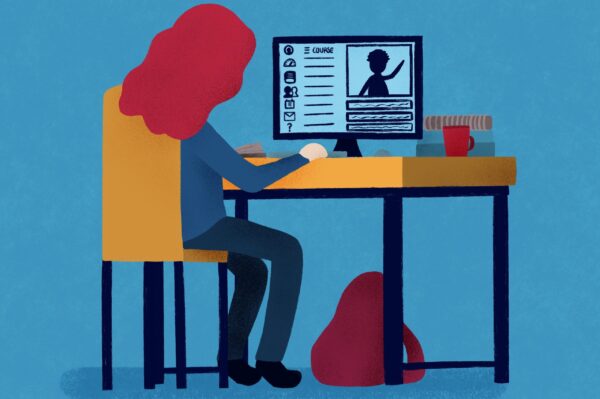Online classes were becoming increasingly common even before the COVID-19 crisis. As the pandemic disrupted systems across the world, however, educational institutions found themselves transitioning to a fully virtual space in a matter of weeks — or, in some cases, days. Fontbonne tackled this transition alongside many other universities this spring, and it did so with a hidden superpower — a staff member named Jo Ann Mattson.
Course Development Process
As Fontbonne’s Director of e-Learning, Mattson works with the university’s deans and department chairs to develop new online programs and courses. This rigorous process typically involves many hours of planning, approval and review.
Once an online program has been approved by all key constituents (Board of Directors, Vice President for Academic Affairs, Dean and undergraduate or graduate faculty review committee), Mattson collaborates with the faculty designer to create a course that adheres to online learning best practices. The course is then reviewed by the department chair, who checks the content and ensures that learning outcomes align with program goals and standards for academic rigor. Finally, Mattson confirms that the class is well-organized and can be easily navigated by students. She then provides support throughout the term and meets with the instructor once it is complete to review student feedback and make any necessary changes. Just like face-to-face courses, online classes go through a yearly evaluation process where other faculty and/or department chairs “visit” the classroom and provide feedback for the instructor.
When Fontbonne made the temporary shift to a fully online learning environment in March, this process had to be condensed for some courses. Despite the significant time constraints, faculty and staff were able to successfully navigate the transition with Mattson’s help.
“I’ve been amazed at how everyone has rallied with support to adapt face-to-face classroom projects and discussions to online activities,” Chancellor Barbara Jennings said. “Students have steadily been reminded that resources are in place to support them mentally, physically and spiritually.”
Making an Online Class Successful
Although many of the classes which were moved online due to COVID-19 were initially developed for an in-person learning environment, Mattson worked closely with faculty members to ensure the transition was as seamless as possible. The first step in this process was the same one she uses for all of Fontbonne’s online classes — ensuring that three key connection points were in place:
- Student-to-faculty
- Student-to-content
- Student-to-student
In other words, a fruitful online learning experience must offer the student opportunities to engage with their instructor, the course content and their peers in meaningful ways. In a traditional classroom, this engagement could occur through small group work, class discussions, note-taking, quizzes and other familiar activities. In a virtual space, these connections can also be established through discussion boards, Zoom calls, wiki pages, course announcements, direct messages, multimedia content and detailed feedback on assignments.
Monitoring students’ grasp of the material on a regular basis is also especially crucial in an online setting. Formative assessments are ongoing, low-stakes assessments (like quizzes or journal entries) that provide more immediate feedback to the instructor than summative assessments like midterms and final exams.
“Building in formative assessments is really important,” Mattson says. “They help the faculty determine where students are in the learning process so they can make changes when needed if students are struggling.”
Blended Learning
Some classes are easy to imagine in an online format, while others — art studios and science labs, for example — seem more challenging. Thanks to the widespread availability of video and audio capture technology, though, even these classes can succeed virtually in a blended or “flipped” learning environment.
In a blended classroom, students watch a video lesson on their own before coming to class. Class time is then used for discussion, group projects and assessment. This approach has traditionally been used to create hybrid online and in-person courses, but it works for fully online classes as well. For a virtual blended course, the in-class portion can take place synchronously through Zoom or asynchronously through discussion boards or wiki pages.
“I joined one of the art classes when they met for the first time to make sure no one had trouble with the technology,” Mattson explained. “They all took turns sharing images of their paintings, reflecting on their own work and discussing the project with the class. It was really cool — I almost didn’t want to leave the course myself!”
Unique Benefits of Online Learning
Students love online classes for the freedom they provide. Since many are offered asynchronously, students are able to control when, where and how they engage with the material. Fontbonne’s robust, user-friendly learning management system (Canvas) and other technological tools like Zoom allow students to accomplish the same goals that they would in a traditional classroom from the comfort of their homes.
Distance learning also creates opportunities for creativity and innovation — a challenge that Fontbonne faculty and students have risen to with surprising vigor.
“I just worked with a history class that created podcasts to show the faculty they had learned the material,” Mattson said. “The faculty member loved the project and says she’ll be implementing it again whether the class is meeting face-to-face or online.”
Across the university, instructors are inventing new approaches and strategies for providing students with the rigorous academic experience they deserve. Over the past several weeks, faculty have created their own instructional videos about topics ranging from ceramics to algebra to gender communication. They’ve held virtual office hours, hosted screencasts about science fiction literature and sent students to their own closets to analyze different types of stitching.
Reflecting on the shift to online learning, instructor James Fortney says, “I have learned that almost any element of a face-to-face course can be converted to a virtual learning environment. Even in cases where an exact replication of an activity or assignment is impossible, simple modifications can be made to ensure the same learning outcomes are met.”
COVID-19 took the world by surprise. Thanks in large part to Mattson’s tireless work and expertise, though, Fontbonne is equipped to ensure a high-quality educational experience for all students — regardless of the format.
“Our faculty are so passionate about their content and about the students,” says Mattson. “They’re very dedicated, they’re willing to try new things, and there are support systems in place for students who are struggling. We’re going to be here for them.”


